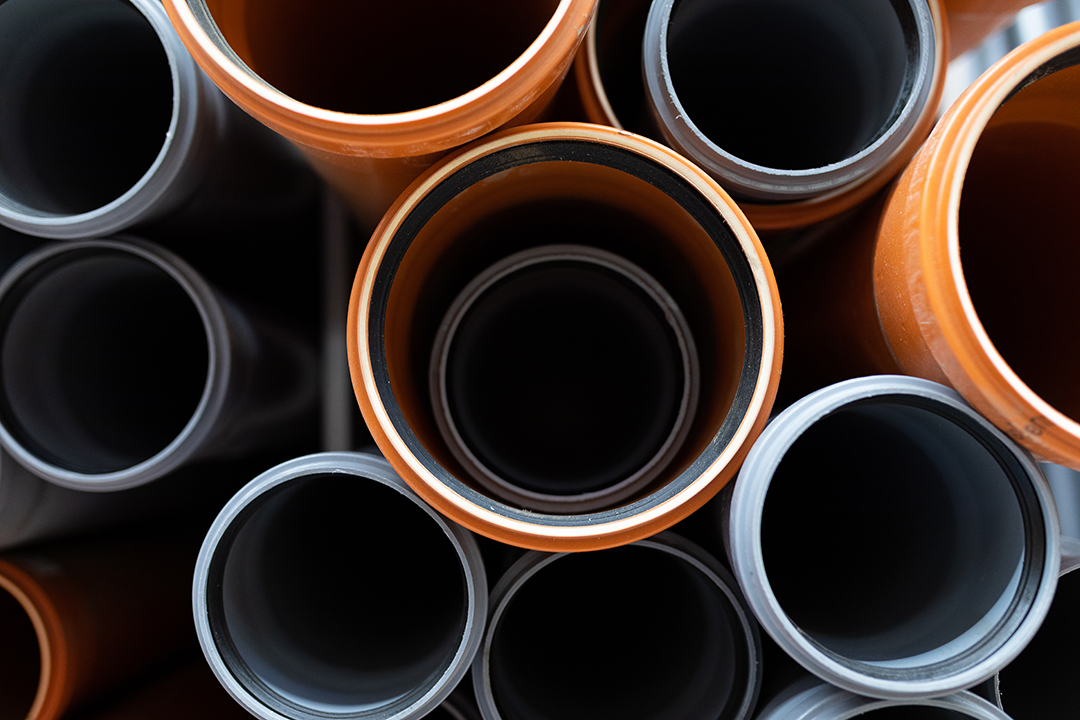High-density polyethylene (HDPE) pipes and fittings are essential components in many industries and are used as water mains, gas mains, sewer mains, slurry transfer lines, fire system supply lines, electrical and communications conduit, irrigation lines, and stormwater and drainage pipes. However, proper handling of HDPE materials is important in maintaining the integrity of the pipe and ensuring their safe installation.
Efficient material handling techniques not only protect the quality of HDPE products but also improve job site safety and project timelines. From unloading and storage to transportation and installation, each step in the HDPE supply chain requires handlers to follow a series of best practices and safety standards.
Types of HDPE Pipe and Tubing
HDPE pipes and tubing come in various sizes and configurations to suit different industrial applications. Understanding the different specifications of each HDPE pipe product is important for its proper handling and storage:
- Coiled HDPE tubing: Flexible and ideal for smaller-diameter applications.
- Straight-length HDPE pipes: Rigid pipes that are typically used for larger-diameter applications.
- HDPE fittings: Connectors, elbows, and other components used to join HDPE pipes.
Each type of HDPE Pipe and HDPE Tubing requires specific handling techniques to prevent damage and ensure safe installation. Pipefitters must be knowledgeable about these techniques and understand different methods of installation for each type of pipe or tubing.
Safety Considerations in HDPE Supply Handling
Safety should always be the top priority when handling HDPE materials. Here are some key safety guidelines for pipefitters to follow:
- Wear appropriate personal protective equipment (PPE), including hard hats, steel-toed boots, and gloves.
- Use proper lifting techniques to prevent injuries.
- Be aware of potential hazards on the job site, such as uneven terrain or overhead obstacles.
- Follow OSHA guidelines for trench safety when installing HDPE pipes.
Unloading and Inspecting HDPE Supplies
The arrival of HDPE supplies at your site is a critical moment in the material handling process. Proper unloading and thorough inspection are essential to ensure the quality and integrity of the products you’ve received. These initial steps can prevent costly delays and safety issues, setting the stage for smooth project execution:
- Ensure the truck is parked on level ground and the wheels are locked.
- Inspect the load for any shifting or damage during transport.
- Use appropriate equipment for unloading, such as forklifts or cranes with proper attachments.
- Check the packing list to confirm the received products match the order.
- Inspect pipes and fittings for any visible damage or defects.
Proper Lifting and Handling Techniques
Correct lifting and handling techniques are crucial for preventing damage to HDPE materials and reducing injury risks. Let’s explore both manual and mechanical lifting methods:
Manual Lifting
OSHA recommends applying ergonomic principles to reduce musculoskeletal complaints to job site workers. When lifting HDPE pipes manually, follow these key guidelines:
- Use proper body mechanics: Lift with your legs, not your back. Keep your knees and back as straight as possible, and maintain a shoulder-width stance for stability.
- Team lifting for heavy pipes: Designate one person to direct the lift. Ensure everyone lifts simultaneously and keeps the load level.
- Use appropriate tools: Employ carrying tools like pipe tongs, slings, or U-shaped carrying bars for better grip and control, especially with long pipes.
Always inspect materials for hazards before handling them. Be cautious with wet or snow-covered pipes, which can be extremely slippery. If you have stored the pipes outside, check their temperature first, as they can become very hot in direct sunlight.
Remember: Never lift more than you can handle safely. When in doubt, use mechanical aids.
Mechanical Lifting
When manual lifting isn’t feasible, use mechanical equipment following these guidelines:
| Equipment | Guidelines |
| Forklifts |
|
| Cranes |
|
General safety guidelines for all mechanical lifting:
- Never exceed the rated capacity of lifting equipment.
- Inspect all equipment before use for signs of wear or damage.
- Avoid sudden movements when operating equipment.
- Ensure all personnel are properly trained and follow OSHA regulations.
These practices help maintain a safe working environment, protecting both workers and HDPE materials during lifting and handling operations.
Storage Guidelines for HDPE Pipes and Fittings
Proper storage of HDPE materials is critical to maintain their quality and performance. Careful attention to storage conditions ensures your HDPE supplies remain in optimal condition until installation.
| Storage Aspect | Guideline |
| Surface | Store on a flat, level surface that is free of debris. |
| Stacking | Stack pipes in a pyramidal fashion, with thicker pipes at the bottom. |
| Protection | Use UV-resistant tarps for outdoor storage of non-black HDPE pipes. |
| Fittings | Store in the original packaging or containers to prevent damage. |
Transportation Considerations
Proper transportation of HDPE pipes and fittings ensures that your materials arrive undamaged and prevents project delays. Key factors include:
- Secure loads with straps or chains, using one strap per 5 feet of trailer length. Tighten belly straps before top straps.
- Use clean dunnage between pipe layers to prevent damage.
- Follow DOT regulations for weight limits, load distribution, and warning signals for oversized loads.
- Choose appropriate transportation methods: flatbed trailers for long pipes, specialized trailers for extra-long pipes, and enclosed trailers for weather-sensitive loads.
- Plan routes to accommodate load size and weight restrictions.
- Inspect loads regularly, especially after the first 50 miles.
- Consider weather conditions that may affect load stability.
- Use pipe caps or tarps to protect pipe interiors from debris and fumes.
These practices help ensure safe delivery and maintain HDPE material integrity throughout transport.
Installation Best Practices
Proper installation ensures the longevity and performance of HDPE piping systems. Key practices include:
- Prepare the installation site according to project specifications, ensuring proper trench dimensions and removing potential pipe-damaging debris.
- Use appropriate joining methods like heat fusion or mechanical coupling. Heat fusion creates joints as strong as the pipe itself when done correctly.
- Follow manufacturer guidelines for fusion equipment operation, paying close attention to temperature, pressure, and cooling time.
- Conduct thorough testing and inspection of joints before backfilling, including visual checks and pressure tests as specified.
- Use proper bedding and backfill materials with correct compaction techniques to provide long-term support for the pipeline.
These practices help ensure your HDPE piping system’s reliability, performance, and safety throughout its service life.
Environmental Considerations
HDPE pipes offer many environmental benefits, but proper handling is important:
- Minimize waste by careful planning and cutting of each pipe or tubing length.
- Recycle scrap HDPE materials when possible.
- Follow local regulations for the disposal of any non-recyclable materials.
- Consider the carbon footprint of transportation when sourcing HDPE supplies.
Choosing the Right HDPE Supply Partner
Selecting a reliable HDPE supply partner is important to ensure that you are using quality materials and efficient handling methods. Coastal Resource Group stands out as a leading supplier of HDPE pipes, fittings, tools, and equipment. With our extensive inventory, fast delivery, and expert support, we can help keep your projects on track. Our team understands the importance of proper material handling and can guide best practices for your specific application.
For all your HDPE supply needs, from pipes and fittings to specialized equipment, trust Coastal Resource Group to deliver quality products and exceptional service. Contact us today to learn how we can support your HDPE piping projects with efficient material handling solutions.


